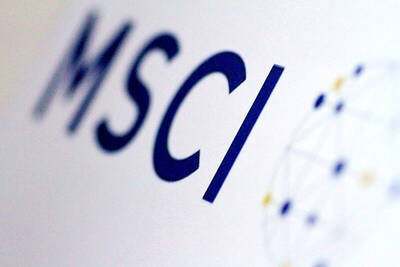Private consumption, which has taken a hit due to a local COVID-19 outbreak that started in May, is not expected to recover until the middle of next year, given Taiwan’s low vaccination coverage and a potential second or third outbreak, Singapore-based DBS Bank Ltd said yesterday.
It might take a year for Taiwanese private consumption to fully recover, according to the bank’s prediction model, DBS economist Ma Tieying (馬鐵英) told a videoconference.
“We expect the nation’s private consumption to represent a Nike-swoosh recovery as those of Japan and South Korea did last year. It means that the consumption would rebound fast in the third quarter, but grow at a slower pace in the fourth quarter and next year,” Ma said.

Photo: Lee Chin-hui, Taipei Times
A full recovery in private consumption would require high vaccination coverage, which DBS expects would be in the first half of next year for Taiwan, she said.
As of Wednesday last week, Taiwan had a vaccination coverage rate of 20.1 percent, much lower than the 70 percent scientists projected would be needed to achieve herd immunity, she said.
Moreover, scientists have revised the herd immunity threshold to 80 percent after experts found some vaccines less effective against the SARS-CoV-2 Delta variant, she added.
Taiwan would need more than 30 million doses of vaccine to achieve herd immunity, whether its target vaccination coverage is 70 or 80 percent, she said, adding that she does not expect the nation to receive that amount within a short period.
Even the pandemic has weakened private consumption, DBS maintained its forecast that the Taiwanese economy would grow 5 percent this year, as stronger-than-expected manufacturing, exports and investment should offset the impact on domestic consumption, Ma said.
The Directorate-General of Budget, Accounting and Statistics forecast GDP growth of 5.5 percent for this year.
“Local supply chains were barely affected by the pandemic and we predict exports to continue expanding at a double-digit rate in the second of half of next year, as world demand for semiconductors and electronic components hold amid a global economic recovery,” Ma said.
Taiwan’s GDP is estimated to have grown 5.9 percent in the second quarter from a year earlier, and is expected to rise 3.2 percent this quarter and 2.6 percent next quarter, she said.
On a quarterly basis, the nation’s GDP likely fell 13.3 percent last quarter due to the local outbreak, but DBS expects it to return to positive territory this and next quarter, with increases of 9.5 percent and 3.6 percent respectively, she said.
The central bank is not expected to hike interest rates until the end of next year, she said.
“We believe the central bank will take into account the fact that Taiwan’s economic growth is uneven, with the semiconductor and electronic sectors prospering and other sectors suffering from the coronavirus, and in such a situation a boost in interest rates would hurt further the struggling sectors,” Ma said.
The central bank would not raise interest rates until every sector recovers, she said.

PERSISTENT RUMORS: Nvidia’s CEO said the firm is not in talks to sell AI chips to China, but he would welcome a change in US policy barring the activity Nvidia Corp CEO Jensen Huang (黃仁勳) said his company is not in discussions to sell its Blackwell artificial intelligence (AI) chips to Chinese firms, waving off speculation it is trying to engineer a return to the world’s largest semiconductor market. Huang, who arrived in Taiwan yesterday ahead of meetings with longtime partner Taiwan Semiconductor Manufacturing Co (TSMC, 台積電), took the opportunity to clarify recent comments about the US-China AI race. The Nvidia head caused a stir in an interview this week with the Financial Times, in which he was quoted as saying “China will win” the AI race. Huang yesterday said

Nissan Motor Co has agreed to sell its global headquarters in Yokohama for ¥97 billion (US$630 million) to a group sponsored by Taiwanese autoparts maker Minth Group (敏實集團), as the struggling automaker seeks to shore up its financial position. The acquisition is led by a special purchase company managed by KJR Management Ltd, a Japanese real-estate unit of private equity giant KKR & Co, people familiar with the matter said. KJR said it would act as asset manager together with Mizuho Real Estate Management Co. Nissan is undergoing a broad cost-cutting campaign by eliminating jobs and shuttering plants as it grapples

The Chinese government has issued guidance requiring new data center projects that have received any state funds to only use domestically made artificial intelligence (AI) chips, two sources familiar with the matter told Reuters. In recent weeks, Chinese regulatory authorities have ordered such data centers that are less than 30 percent complete to remove all installed foreign chips, or cancel plans to purchase them, while projects in a more advanced stage would be decided on a case-by-case basis, the sources said. The move could represent one of China’s most aggressive steps yet to eliminate foreign technology from its critical infrastructure amid a

MORE WEIGHT: The national weighting was raised in one index while holding steady in two others, while several companies rose or fell in prominence MSCI Inc, a global index provider, has raised Taiwan’s weighting in one of its major indices and left the country’s weighting unchanged in two other indices after a regular index review. In a statement released on Thursday, MSCI said it has upgraded Taiwan’s weighting in the MSCI All-Country World Index by 0.02 percentage points to 2.25 percent, while maintaining the weighting in the MSCI Emerging Markets Index, the most closely watched by foreign institutional investors, at 20.46 percent. Additionally, the index provider has left Taiwan’s weighting in the MSCI All-Country Asia ex-Japan Index unchanged at 23.15 percent. The latest index adjustments are to